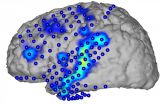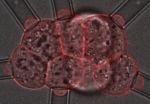(Press-News.org) Researchers of the Max Delbrück Center for Molecular Medicine (MDC) in the Helmholtz Association, in collaboration with the National Heart Research Institute Singapore (NHRIS), have gained new insights into the regulation of disease-associated genes. They used a new technique that enables them to observe gene regulation at the level of protein production. They could thus capture more individual gene regulations than with traditional methods that only capture gene expression and transcription (Nature Communications, doi: 10.1038/ncomms8200)*.
When a gene is read, its blueprint for proteins encoded in the language of DNA is transcribed in the cell nucleus into RNA. 'At this level, many but by far not all of the individual differences in gene regulation can be identified,' said Professor Norbert Hübner, senior author of the publication and head of the research group Genetics and Genomics of Cardiovascular Diseases at the MDC. Together with Sebastian Schafer (MDC, NHRIS) and Eleonora Adami (MDC), as well as researchers from several research institutions in Berlin, the Netherlands, England and the Czech Republic, they investigated gene regulation on the next level, translation. It takes place outside the cell nucleus, in the cell plasma. During translation, the RNA sequence is translated into amino acid sequences and assembled into proteins in the protein factories of the cell, the ribosomes.
First, the researchers searched the entire genome of two strains of rats, -- one strain had high blood pressure, the other strain not -- and specifically investigated genes of the heart and liver tissue. Then they used a new technique called ribosome profiling, abbreviated ribo-seq, which enables them to determine what proportion of the transcriptome is actively translated into proteins. The result: They observed almost double the number of differentially expressed heart and liver genes in translation as in transcription. Next, they compared these data with the corresponding human genes in genome-wide association studies. This comparison revealed that a large number of heart and liver genes in humans are regulated primarily during translation. The researchers are confident that capturing interindividual differences in the translated genome will lead to new insights into the genes and regulatory pathways underlying disease.
INFORMATION:
*Translational regulation shapes the molecular landscape of complex disease phenotypes
Sebastian Schafer1,2,*, Eleonora Adami1,*, Matthias Heinig1,3, Katharina E. Costa Rodrigues1, Franziska Kreuchwig1, Jan Silhavy4, Sebastiaan van Heesch1, Deimante Simaite1, Nikolaus Rajewsky5,6, Edwin Cuppen7, Michal Pravenec4, Martin Vingron3, Stuart A. Cook2,8,9 & Norbert Hübner1,6,10
1Cardiovascular and Metabolic Sciences, Max Delbrück Center for Molecular Medicine (MDC) in the Helmholtz Association, Robert-Rössle-Strasse 10, 13125 Berlin, Germany.
2National Heart Research Institute Singapore (NHRIS), National Heart Centre Singapore, Singapore 169609, Singapore.
3Department of Computational Molecular Biology, Max Planck Institute for Molecular Genetics, Ihnestrasse 63-73, 14195 Berlin, Germany.
4Institute of Physiology, Academy of Sciences of the Czech Republic, Vídenska 1083, 142 20 Prague 4, Czech Republic.
5Systems Biology of Gene Regulatory Elements, Max Delbrück Center for Molecular Medicine (MDC) in the Helmholtz Association, Robert-Rössle-Strasse 10, 13125 Berlin, Germany.
6DZHK (German Centre for Cardiovascular Research), Partner Site, 13347 Berlin, Germany.
7Hubrecht Institute-KNAW & University Medical Center Utrecht, Uppsalalaan 8, 3584 CT Utrecht, The Netherlands.
8National Heart and Lung Institute, Imperial College London, London SW3 6NP, UK.
9Duke-National University of Singapore, Singapore 169857, Singapore.
10Charité Universitätsmedizin, 10117 Berlin, Germany.
* These authors contributed equally to this work.
Contact:
Barbara Bachtler
presse@mdc-berlin.de
49 (0) 30 94 06 - 38 96 or 49 (0) 30 94 06 - 38 33 (fax)
Max Delbrück Center for Molecular Medicine (MDC) Berlin-Buch
https://www.mdc-berlin.de/en
Researchers from North Carolina State University have created stretchable, transparent conductors that work because of the structures' "nano-accordion" design. The conductors could be used in a wide variety of applications, such as flexible electronics, stretchable displays or wearable sensors.
"There are no conductive, transparent and stretchable materials in nature, so we had to create one," says Abhijeet Bagal, a Ph.D. student in mechanical and aerospace engineering at NC State and lead author of a paper describing the work.
"Our technique uses geometry to stretch ...
Researchers from the ARC Centre of Excellence for Coral Reef Studies at James Cook University have discovered that suspended sediment damages fish gills and can increase the rate of disease in fish.
"Suspended sediments result from flood plumes, coastal agricultural and industrial development and from dredging operations and are increasing in coastal waters worldwide," says study co-author, Dr Amelia Wenger.
"Fish gills are in direct contact with their environment and are the first line of defence in the animal's immune response, which makes them the perfect place ...
University of Tokyo researchers have discovered the structure and transport properties of the "intermediate state" in lithium-ion batteries - key to understanding the mechanisms of charge and discharge in rechargeable batteries. These findings may help accelerate battery reaction speed and significantly shorten battery charging time.
Although there is strong demand to minimize battery-charging time, the mechanisms of battery charge and discharge reactions have yet to be fully understood. While the existence of an "intermediate state" that accelerates battery charge and ...
Researchers have discovered that extreme exercise can cause intestinal bacteria to leak into the bloodstream, leading to blood poisoning.
Experts at Monash University monitored people participating in a range of extreme endurance events, including 24-hour ultra-marathons and multi-stage ultra-marathons, run on consecutive days.
"Blood samples taken before and after the events, compared with a control group, proved that exercise over a prolonged period of time causes the gut wall to change, allowing the naturally present bacteria, known as endotoxins, in the gut to ...
A promising type of vaccine designed to eradicate malaria by blocking parasite transmission could be a step closer, as a result of experts uncovering new information about the targeted protein.
The international team of researchers co-led by Dr Natalie Borg from the Department of Biochemistry and Molecular Biology at Monash University, and Dr Rhoel Dinglasan from the Malaria Research Institute at the Johns Hopkins Bloomberg School of Public Health in Baltimore, USA, focused on a protein in the Anopheles mosquito midgut called AnAPN1.
The research, published in the journal ...
Restricting teenagers from driving unsupervised at night, and introducing strict penalties and other licensing requirements, could reduce crashes significantly, according to research.
Published in Health Affairs, the study by researchers from Monash University and Harvard Medical School, shows that driving laws that eliminate or deter unsupervised night driving by people younger than 18 achieve substantial reductions in car crashes.
Car crashes are the leading cause of death among people aged 15-19 worldwide. In the US, where the study was based, teen drivers experience ...
This news release is available in German.
Speech is produced in the human cerebral cortex. Brain waves associated with speech processes can be directly recorded with electrodes located on the surface of the cortex. It has now been shown for the first time that is possible to reconstruct basic units, words, and complete sentences of continuous speech from these brain waves and to generate the corresponding text. Researchers at KIT and Wadsworth Center, USA present their "Brain-to-Text" system in the scientific journal Frontiers in Neuroscience (doi: 10.3389/fnins.2015.00217). ...
For breast cancer to be fatal, the tumor has to send out metastases to other parts of the body. The cancer cells are spread via the blood vessels, and a research team at Lund University in Sweden has now proven that the protein ALK1 determines the extent of the tumor's spread in the body. The higher the levels of the protein on the surface of the blood vessels, the greater their permeability to tumor cells and therefore the greater the risk of metastases.
The new study also shows that the drug Dalantercept can prevent the spread of tumour cells in breast cancer by blocking ...
This news release is available in German.
In 1915 Albert Einstein formulated the theory of general relativity which fundamentally changed our understanding of gravity. He explained gravity as the manifestation of the curvature of space and time. Einstein's theory predicts that the flow of time is altered by mass. This effect, known as "gravitational time dilation", causes time to be slowed down near a massive object. It affects everything and everybody; in fact, people working on the ground floor will age slower than their colleagues a floor above, by about 10 nanoseconds ...
The same kind of contraction that fires our muscles also controls a key stage of mammalian embryo development, according to a new study published in Nature Cell Biology. The research, conducted at EMBL Heidelberg, measured and mapped how cells in very early stage embryos bond tightly together. The scientists also discovered a cellular behaviour that hadn't been observed before: cells in the embryo 'dance', each one making the same rhythmic movement.
The focus of the study was a stage of development known as compaction, which takes place when the embryo has eight cells. ...





